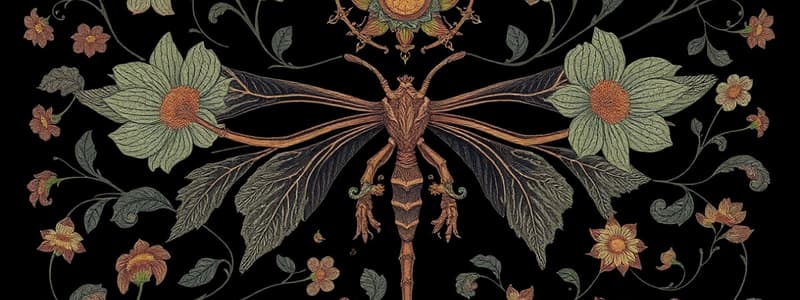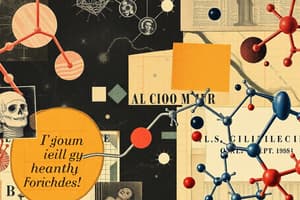Podcast
Questions and Answers
What is the primary function of the aorta?
What is the primary function of the aorta?
- Distributing oxygenated blood from the heart to the rest of the body (correct)
- Pumping oxygenated blood to the lungs
- Receiving deoxygenated blood from the body
- Carrying deoxygenated blood to the body
Which of the following best describes the structure of phylogenetic trees?
Which of the following best describes the structure of phylogenetic trees?
- They represent only extinct species.
- They show only the species' names.
- They are linear with no branches.
- They are organized into clades based on evolutionary relationships. (correct)
The left ventricle is responsible for pumping deoxygenated blood to the lungs.
The left ventricle is responsible for pumping deoxygenated blood to the lungs.
False (B)
All six kingdoms of life share the same key identifying characteristics.
All six kingdoms of life share the same key identifying characteristics.
What are X-linked disorders?
What are X-linked disorders?
The organ of gas exchange in mammals is the __________.
The organ of gas exchange in mammals is the __________.
What are the two laws of heredity discovered by Mendel?
What are the two laws of heredity discovered by Mendel?
Match the following fungi phyla with their descriptions:
Match the following fungi phyla with their descriptions:
The _____ is the phase of the cardiac cycle where the heart muscle relaxes.
The _____ is the phase of the cardiac cycle where the heart muscle relaxes.
Match the following phyla with their key characteristics:
Match the following phyla with their key characteristics:
What is a significant event during telophase II of meiosis?
What is a significant event during telophase II of meiosis?
Monocots and dicots can be completely sorted into two categories without any overlap.
Monocots and dicots can be completely sorted into two categories without any overlap.
What characterizes a bacteriophage?
What characterizes a bacteriophage?
Define genotype and phenotype.
Define genotype and phenotype.
Oxygen diffuses from the capillaries into the alveoli.
Oxygen diffuses from the capillaries into the alveoli.
The __________ is the part of the heart that separates the left and right chambers.
The __________ is the part of the heart that separates the left and right chambers.
What are autosomes?
What are autosomes?
The primary tool used in gene editing is called _____ technology.
The primary tool used in gene editing is called _____ technology.
At what stage of meiosis does non-disjunction typically occur?
At what stage of meiosis does non-disjunction typically occur?
Which of the following is NOT a characteristic of all plants?
Which of the following is NOT a characteristic of all plants?
Flashcards
Metaphase II
Metaphase II
The process where chromosomes line up at the center of the cell during Meiosis II.
Anaphase I
Anaphase I
The process where chromosomes are pulled apart and move to opposite poles of the cell during Meiosis I.
Prophase I
Prophase I
The process where homologous chromosomes pair up and exchange genetic material during Meiosis I.
Bilateral Symmetry
Bilateral Symmetry
Signup and view all the flashcards
Radial Symmetry
Radial Symmetry
Signup and view all the flashcards
Asymmetry
Asymmetry
Signup and view all the flashcards
Meiosis
Meiosis
Signup and view all the flashcards
Mitosis
Mitosis
Signup and view all the flashcards
Bacteriophage Infectious Cycle
Bacteriophage Infectious Cycle
Signup and view all the flashcards
Bacteriophage
Bacteriophage
Signup and view all the flashcards
Telophase II
Telophase II
Signup and view all the flashcards
Aorta
Aorta
Signup and view all the flashcards
Pulmonary vein
Pulmonary vein
Signup and view all the flashcards
Right atrium
Right atrium
Signup and view all the flashcards
Left ventricle
Left ventricle
Signup and view all the flashcards
Septum
Septum
Signup and view all the flashcards
Phylum Glomeromycota
Phylum Glomeromycota
Signup and view all the flashcards
Phylum Ascomycota
Phylum Ascomycota
Signup and view all the flashcards
Bryophytes
Bryophytes
Signup and view all the flashcards
Study Notes
Grade 11 Biology Exam Review - January 24th
- Exam Structure: 20 multiple choice, 15 matching, 15 true/false, 10 diagrams, 40 short answer.
Part A: Multiple Choice
- Linnaean Taxonomy (Section 1.2): Understand the hierarchical ranks (e.g., kingdom, phylum, class) and their arrangement.
- Phylogenetic Trees and Clades (Section 1.3): Know how phylogenetic trees illustrate evolutionary relationships and are organized into clades. Visualize this in a diagram.
- Kingdom Characteristics (Section 1.4): Define and differentiate characteristics distinguishing the six kingdoms.
- Domains and Kingdoms (Section 1.4): Identify the three domains (Bacteria, Archaea, Eukarya) and associated kingdoms.
- Bacteriophages (Section 2.2): Understand bacteriophages, including their structure and the lytic/lysogenic cycles.
- Plant Characteristics (Section 3.2): Recall shared characteristics defining all plants.
- Animal Symmetries (Section 3.3): Identify animal groups with bilateral, radial, or no symmetry.
- Oogenesis and Spermatogenesis (Section 4.3): Compare and contrast the processes of egg and sperm formation.
- Mendel's Laws of Heredity (Section 5.1): Define and understand the principles of segregation and independent assortment.
- Meiosis I vs. Meiosis II (Section 4.3): Differentiate the key events and processes occurring in each step.
- Autosomes and Sex Chromosomes (Section 4.3): Define the terms and their roles in determining traits.
- Down Syndrome (Section 4.4): Explain the genetic basis of Down Syndrome, including non-disjunction.
- Blood Type Inheritance (Section 5.2): Describe how human blood type is inherited.
- Genetic Modification Tools (Section 6.4): Name and describe the crucial tools used in genetic engineering.
- Nutrients in Diet (Section 9.2): List and define the six main nutrients.
- Small Intestine Digestion (Section 9.5): Explain the digestive processes within the small intestine.
- Gas Exchange Location (Section 10.2): Identify the site of gas exchange in the body.
- Oxygen Diffusion (Section 10.2): Explain the reasons for the diffusion of oxygen from the alveoli to the capillaries.
- Artery and Vein Structure (Section 11.3): Compare the structural characteristics of arteries and veins.
- Systole and Diastole (Section 11.4): Define and understand these key terms related to heart function.
Part B: Matching
- Phylum Arthropoda (Section 3.3): Identify defining characteristics.
- Phylum Nematoda (Section 3.3): Identify defining characteristics.
- Phylum Annelida (Section 3.3): Identify defining characteristics.
- Phylum Mollusca (Section 3.3): Identify defining characteristics.
- Phylum Platyhelminthes (Section 3.3): Identify defining characteristics.
- Anaphase I (Section 4.3): Describe the key events of this stage of meiosis.
- Metaphase II (Section 4.3): Describe the key events of this stage of meiosis.
- Prophase I (Section 4.3): Describe the key events of this stage of meiosis.
- Telophase II (Section 4.3): Describe the key events of this stage of meiosis.
- Metaphase I (Section 4.3): Describe the key events of this stage of meiosis.
- Aorta Function (Section 11.4): Describe the function of the aorta.
- Pulmonary Vein Function (Section 11.4): Describe the function of the pulmonary vein.
- Right Atrium Function (Section 11.4): Describe the function of the right atrium.
- Left Ventricle Function (Section 11.4): Describe the function of the left ventricle.
- Septum Function (Section 11.4): Describe the function of the septum.
Part C: True or False
-
Glomeromycota Fungi (Section 3.1): Describe the characteristics and functions of Glomeromycota fungi.
-
Ascomycota Fungi (Section 3.1): Describe the characteristics and functions of Ascomycota fungi.
-
Viruses as Non-living Agents (Section 2.2): Explain why viruses are considered nonliving.
-
Bryophytes(Section 3.2): Describe characteristics of bryophytes.
-
Monocots vs. Dicots (Section 3.2): Compare and contrast monocots and dicots.
-
X-linked Disorders (Section 5.3): Explain X-linked genetic disorders.
-
Codominance vs. Incomplete Dominance (Section 5.2): Distinguish between codominance and incomplete dominance.
-
Non-disjunction Disorders (Section 4.4): Explain non-disjunction and the stage of meiosis where it occurs.
-
Karyotype (Section 4.4): Define a karyotype.
-
Genotype and Phenotype (Section 5.1): Define genotype and phenotype.
-
Large Intestine (Section 9.5): Describe the role of the large intestine in digestion.
-
Carbohydrate Digestion (Section 9.4/9.5): Explain physical and chemical carbohydrate digestion.
-
Small Intestine Role (Section 9.5): Describe the role of the small intestine in digestion.
-
Atria and Ventricles (Section 11.4): Compare the physical characteristics of the atria and ventricles..
-
Organs of Gas Exchange (Section 10.2): Identify and describe the organ of gas exchange in worms, fish, and mammals.
Part D: Diagrams
- Diagrams: Prepare to label the human digestive system, the human respiratory system, the bacterial cell, and the anatomy of earthworms and DNA structure.
Part E: Short Answer
- Brown Algae Life Cycle (Section 2.3): Describe alternation of generations in brown algae.
- Pink Snapdragon Cross (Section 5.2): Predict the genotypes and phenotypes of a cross between pink snapdragons.
- Circulatory System Functions (Section 11.1): Identify the functions of the circulatory system.
- Homologous vs. Analogous Features (Genetics ISU): Differentiate homologous and analogous features.
- Natural Selection (Genetics ISU): Explain natural selection.
- Vestigial Features (Genetics ISU): Describe vestigial features and provide a human example.
- Evidence for Evolution (Genetics ISU): Outline three pieces of evidence supporting evolution.
- Annelida, Platyhelminthes, and Nematoda Anatomy (Section 3.3): Compare the anatomy and characteristics of these three phyla.
- Digestive Enzymes and Hormones (Section 9.3-9.5): List and describe the functions of all digestive enzymes and hormones learned.
- Recessive X-linked Pedigree (Section 5.3): Determine unknown genotypes in a pedigree chart for a recessive X-linked trait.
Studying That Suits You
Use AI to generate personalized quizzes and flashcards to suit your learning preferences.




